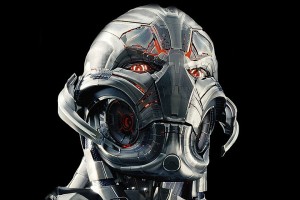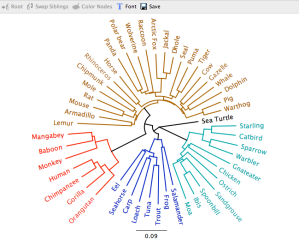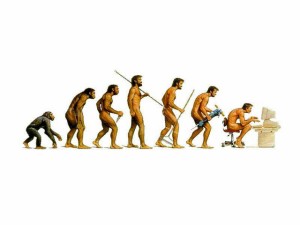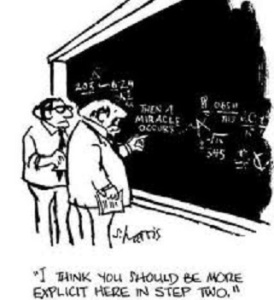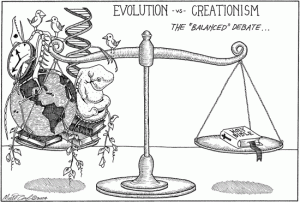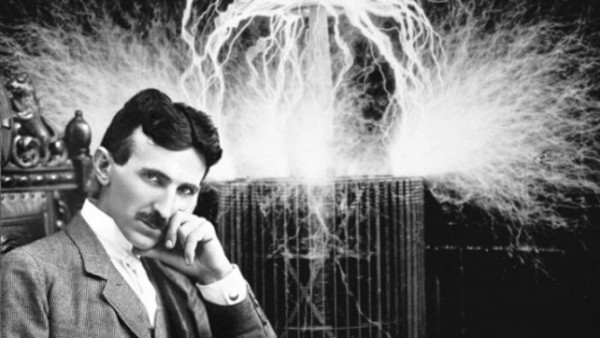 Nicola Tesla, one of the greatest inventors in history, was born 160 years ago today, July 10, 1856, and in the 160 years since, his legend has only grown. In his honor, here is a brief excerpt about him from my book, They Called Me Mad. Enjoy.
Nicola Tesla, one of the greatest inventors in history, was born 160 years ago today, July 10, 1856, and in the 160 years since, his legend has only grown. In his honor, here is a brief excerpt about him from my book, They Called Me Mad. Enjoy.
In 1888, Tesla was invited to deliver a lecture on the benefits of alternating current before the American Institute of Electrical Engineers. One of those present at the lecture, Dr. B. A. Behrend, later commented, “Not since the appearance of Faraday’s ‘Experimental Researches in Electricity’ has a great experimental truth been voiced so simply and so clearly…He left nothing to be done by those who follow him. His paper contained the skeleton even of the mathematical theory.”
Word of Tesla’s success and his new and improved system soon spread through Wall Street. There it came to the attention of George Westinghouse. Westinghouse was an inventor himself, who had developed an improved type of airbrake for trains. He had parlayed his inventions and investments into an empire of business interests, and in the process, become one of the most influential business men in America. He had long been interested in AC power, even investing in one of the earlier systems before Tesla’s improved version came along.
 The walrus mustached business magnate went to Tesla’s lab to see for himself what the young upstart had come up with. Within moments of his arrival, Westinghouse was craning and bending to get a better look at the wondrous machines and gadgets that filled Tesla’s lab. The business man was soon asking the young inventor questions about this device or that. Tesla was impressed with the intelligence of the questions. The two men had a natural affinity for one another, and quickly became friends.
The walrus mustached business magnate went to Tesla’s lab to see for himself what the young upstart had come up with. Within moments of his arrival, Westinghouse was craning and bending to get a better look at the wondrous machines and gadgets that filled Tesla’s lab. The business man was soon asking the young inventor questions about this device or that. Tesla was impressed with the intelligence of the questions. The two men had a natural affinity for one another, and quickly became friends.
Almost immediately, Westinghouse saw these advantages of Tesla’s AC system. He offered Tesla $60,000 for his patents, including $5,000 in cash and 150 shares of Westinghouse stock. As amazing as that amount of money was back then, the offer also included a royalty of $2.50 per horsepower for the electricity sold. Within a very few years, a royalty like that would be worth a mind boggling amount of money. Potentially, it could make Tesla one of the richest inventors in the world.
Once the documents were drawn up, and the ink on the signatures was dry, Westinghouse set about promoting Tesla’s new system for AC power. He hired Tesla to work as a consultant on the installation of the system, paying him a salary of $2,000 per month. Of course, since Westinghouse’s operations were headquartered in Pittsburg, it required that Tesla move to the city, but that was a small price to pay to see his dream of AC power become a reality.
In the midst of his work for Westinghouse, Tesla achieved what he described as his greatest accomplishment. On July 30, 1891, Nikola Tesla became a U.S. citizen. In later years, he often told friends that he valued that more than all the scientific honors that were bestowed upon him. Evidence for that is provided by the many honorary degrees which he tossed carelessly into drawers, while his certificate of naturalization, Tesla always kept secure in his office safe.
War of the Currents
Thomas Edison was outraged when he heard of Tesla’s deal with Westinghouse. Here was a real threat to his DC monopoly, and a threat that the Wizard of Menlo Park had no intention of taking lying down. The battle lines were drawn. While Tesla had Westinghouse on his side, Edison had the backing of J.P. Morgan, one of the world’s most powerful bankers, and a man whose influence reached all corners of commerce and government. What ensued would come to be known as The War of the Currents. The stakes were the chance to harness the power of Niagara Falls.
An international committee was convened to award the contract for a system that would use Niagara Falls to generate electricity. Both sides relished that prize. While Westinghouse began to publicize the advantages of AC, Edison responded by launching a publicity campaign of his own about its dangers. He was convinced because of the higher voltages possible with AC that it was inherently unsafe. To convince others, he hired local boys to capture neighborhood cats and dogs, which he then proceeded to electrocute with AC before on looking reporters. Edison would then urge them to report on the dangers of people being electrocuted, or “Westinghoused,” as he called it.
These brutal demonstrations escalated over the course of years to include calves, horses, cattle, and ultimately even an unfortunate elephant. In 1903, officials at the Luna Park Zoo in Coney Island decided that Topsy the elephant had become so dangerous that she needed to be euthanized. Over the course of three years, she had killed three of her handlers. Never mind that at least one of them was later discovered to have tried feeding her a lit cigarette. Once the decision was made, a means of dispatching the beast was sought. Edison leapt at the chance.
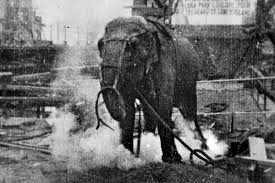 On January 4, 1903, before an audience of 1,500 spectators and reporters, the condemned pachyderm was prepared. Copper electrodes were attached to her feet and wires were run to a generator. When the technicians gave the signal, the switch was thrown and the 6,600 volt AC charge ran through Topsy’s body. As onlookers gasped, smoke rose from her feet, and the mighty elephant keeled over dead. Edison’s assistants filmed the entire spectacle, and the film was later released to the public.
On January 4, 1903, before an audience of 1,500 spectators and reporters, the condemned pachyderm was prepared. Copper electrodes were attached to her feet and wires were run to a generator. When the technicians gave the signal, the switch was thrown and the 6,600 volt AC charge ran through Topsy’s body. As onlookers gasped, smoke rose from her feet, and the mighty elephant keeled over dead. Edison’s assistants filmed the entire spectacle, and the film was later released to the public.
If that weren’t enough to terrify the public, one of Edison’s assistants, Harold P. Brown, had previously developed the ultimate device to demonstrate the horrors of alternating current, the electric chair. The New York State Legislature had shown interest in using electricity to execute convicted criminals, but neither Edison nor Westinghouse wanted their system associated with human executions. However, Edison and Brown managed to covertly obtain several of Westinghouse’s AC generators, and used them for their execution device.
William Kemmler, a convicted murder, was scheduled for execution at Sing Sing Prison on August 6, 1890. While the 17 witnesses watched, electrodes were attached to Kemmler’s body, and he was strapped into the chair. His last words as they put the hood over his head were, “Take it easy and do it properly, I’m in no hurry.” When the order was given, the prisoner received an AC shock of 1,000 volts. He was pronounced dead by the physician present, Dr. Edward Charles Spitzka, but several witnesses said that they saw him breathing.
Once the Dr. Spitzka confirmed that Kemmler was still alive, he cried out, “Have the current turned on again, quick—no delay!” This time they gave the prisoner 2,000 volts. Several of the blood vessels under his skin ruptured, and before the horrified witnesses, Kemmler began to bleed. Several of the witnesses claimed that he caught fire, and reported the smell of burnt flesh. It took eight minutes to complete the execution, and one of the reporters present described it as, “an awful spectacle, far worse than hanging.”
The Chicago World’s Fair
That horrifying scene might have ended the AC versus DC debate, but Westinghouse had a few tricks up his own sleeve. He conceived of a way to demonstrate the wonderful utility and safety of alternating current before the entire world. His scheme unfolded as plans were made for the 1893 Chicago World’s Fair. The Columbia Exposition, as it was called to commemorate the 400th anniversary of Columbus’s discovery of the New World, was to be the first electric world’s fair. Edison made a bid to provide all of the electricity and lights for one million dollars. Westinghouse underbid him by half. With that masterful stroke, he secured for himself and Tesla just the public platform they needed. It would become the decisive battle in the War of the Currents and enshrine Tesla forever among the pantheon of mad scientists.
On May 1st, 1893, President Grover Cleveland turned the gold key that raised flags, switched on fountains and lit 100,000 light bulbs to herald the opening of the Exposition, all of it powered by alternating current. In the course of six months, the fair would welcome 25 million visitors, then approximately 1/3 of the U.S. population. They were treated to the world premiers of the Ferris Wheel, Cracker Jacks and the exotic dancer, Little Egypt, but electricity was the undisputed star of the show. In the Hall of Electricity, Tesla, adorned in white tie and tails and protected by thick cork soled shoes, showcased his electrical wonders before one of his newly developed neon signs proclaiming, “Welcome Electricians.”
He presented to the public an egg shaped copper ball, dubbed the Egg of Columbus that he induced to spin, as if with a life of its own, using rotating magnetic fields. They saw induction motors, transformers, switchboards and polyphase generators. The dashing inventor took glass tubes, the forerunners of today’s fluorescent lights, and caused them to glow without wires, simply by welding them like swords within an electrical field. All of this was accompanied by two insulated plates from which issued lightning-like electrical discharges and claps of thunder. His demonstrations where awe inspiring, as well as death defying. As one of the many newspaper journalists present reported:
Mr. Tesla has been seen receiving through his hands currents at a potential of more than 200,000 volts, vibrating a million times per second, and manifesting themselves in dazzling streams of light…. After such a striking test, which by the way, no one has displayed a hurried inclination to repeat, Mr. Tesla’s body and clothing have continued for some time to emit fine glimmers or halos of splintered light. In fact, an actual flame is produced by the agitation of electrostatically charged molecules, and the curious spectacle can be seen of puissant, white, ethereal flames, that do not consume anything, bursting from the ends of an induction coil as though it were the bush on holy ground.
By the time the fair was over, the battle to see who would win the contract to harness Niagara Falls for hydroelectric power had been won, and Tesla’s fame was assured. It was a monumental project, taking years to complete, but on November 16, 1896, the switch was thrown and Tesla’s AC power lit up the nearby city of Buffalo, New York. He quickly became the toast of high society and one of the most famous men in the world.
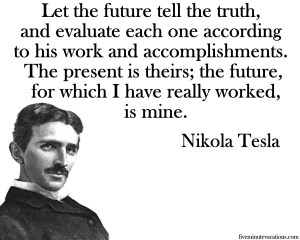
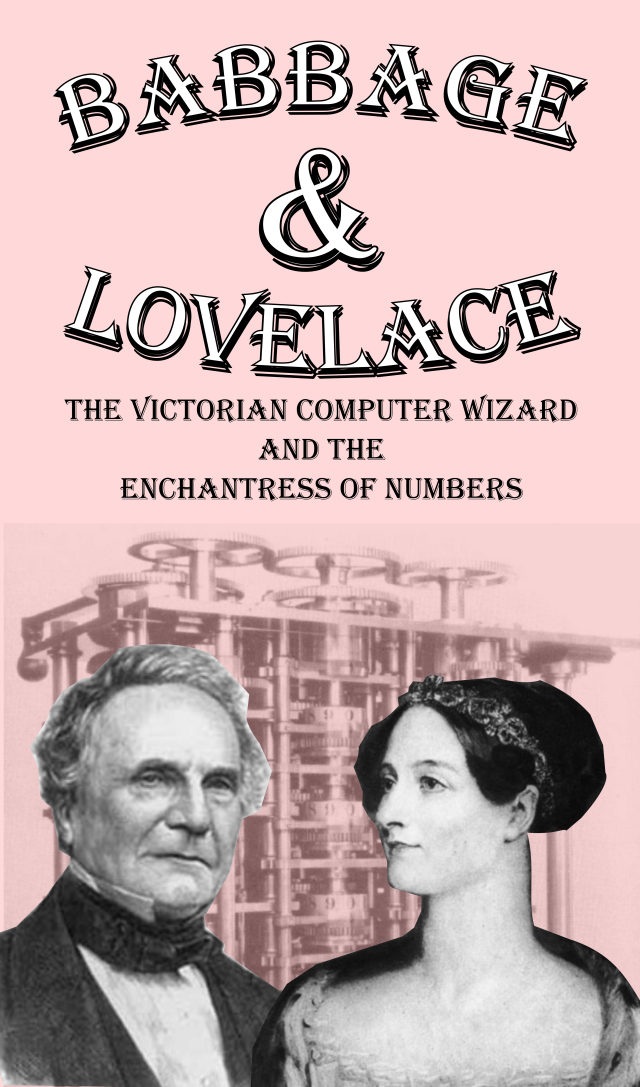 Just in time for Ada Lovelace Day I’m starting off the Kickstarter campaign to fund my newest book Babbage & Lovelace: The Victorian Computer Wizard and the Enchantress of Numbers. It’s the completely true story of the efforts of two of the most intriguing individuals in the history of science, and their efforts to build an actual working computer in the mid-1800’s, Charles Babbage was an iconoclastic mathematician willing to explore radical new technologies who conceived of a mechanical gearwork computer. Ada Lovelace was the daughter of the notorious poet Lord Byron and a brilliant
Just in time for Ada Lovelace Day I’m starting off the Kickstarter campaign to fund my newest book Babbage & Lovelace: The Victorian Computer Wizard and the Enchantress of Numbers. It’s the completely true story of the efforts of two of the most intriguing individuals in the history of science, and their efforts to build an actual working computer in the mid-1800’s, Charles Babbage was an iconoclastic mathematician willing to explore radical new technologies who conceived of a mechanical gearwork computer. Ada Lovelace was the daughter of the notorious poet Lord Byron and a brilliant 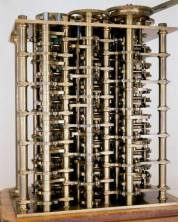 mathematician in her own right. She took Babbage’s ideas, translated them for the public and then expanded upon them. Together they dedicated their lives to bringing the computer revolution to Victorian England, and they very nearly succeeded. Therein lies one of the great what if questions of history as well as the spark that helped launch the Steampunk movement.
mathematician in her own right. She took Babbage’s ideas, translated them for the public and then expanded upon them. Together they dedicated their lives to bringing the computer revolution to Victorian England, and they very nearly succeeded. Therein lies one of the great what if questions of history as well as the spark that helped launch the Steampunk movement.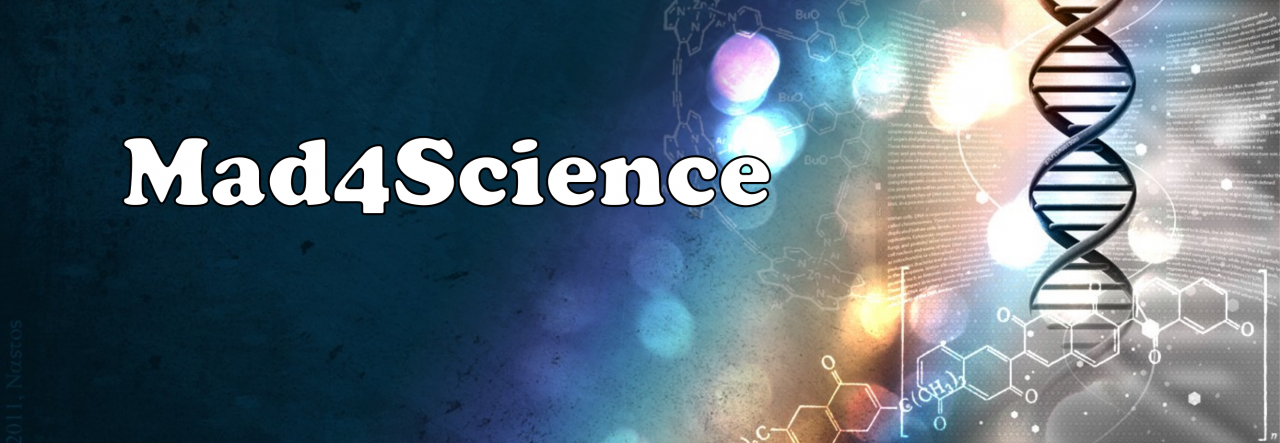
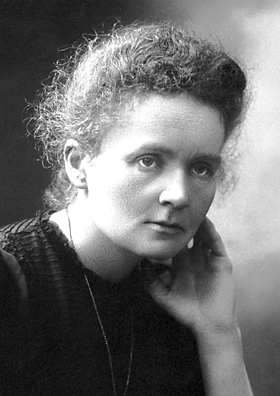
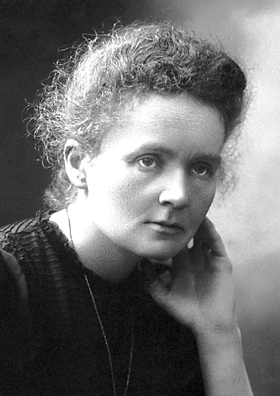 Marie Curie, the woman who discovered radioactivity, found and named two elements and became the only scientist in history to win Nobel Prizes in two different sciences recently came in at the top of a BBC poll on the
Marie Curie, the woman who discovered radioactivity, found and named two elements and became the only scientist in history to win Nobel Prizes in two different sciences recently came in at the top of a BBC poll on the 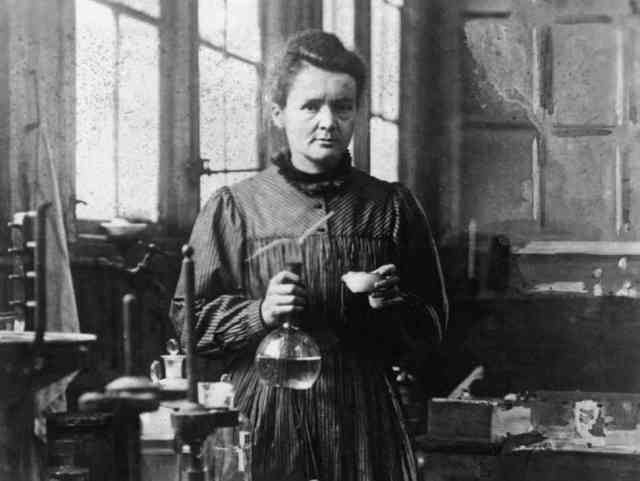 Once Marie had established the strength of the rays given off by pure uranium, she used that as a standard against which to measure other substances. She measured samples of the element thorium and found that they gave off rays too, although not as strongly as the uranium. She then measured a type of ore known as pitchblende. It was a heavy, black ore from which uranium was extracted. Surprisingly, Marie found that even after the extraction, the pitchblende continued to emit rays. In fact the rays she detected coming from the pitchblende were stronger than the rays from pure uranium.
Once Marie had established the strength of the rays given off by pure uranium, she used that as a standard against which to measure other substances. She measured samples of the element thorium and found that they gave off rays too, although not as strongly as the uranium. She then measured a type of ore known as pitchblende. It was a heavy, black ore from which uranium was extracted. Surprisingly, Marie found that even after the extraction, the pitchblende continued to emit rays. In fact the rays she detected coming from the pitchblende were stronger than the rays from pure uranium.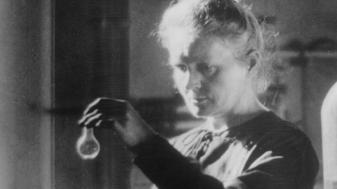 She didn’t stop there. By December, she found a second substance in the pitchblende that behaved like barium. This one was 900 times as radioactive as pure uranium. Believing she had discovered yet another new element, she wanted to confirm her results. One of her colleagues at EPCI, Eugene Demarcay was using a method called spectroscopy. It consisted of heating an element until it became a glowing gas and then using a prism to refract the light given off. The light would form a rainbow pattern or spectra, and each element gave off a unique pattern. On December 19, 1898, Demarcay tested Marie’s new sample and confirmed she had discovered a new element. She named it using the Latin word for ray, radius, and christened the new element radium.
She didn’t stop there. By December, she found a second substance in the pitchblende that behaved like barium. This one was 900 times as radioactive as pure uranium. Believing she had discovered yet another new element, she wanted to confirm her results. One of her colleagues at EPCI, Eugene Demarcay was using a method called spectroscopy. It consisted of heating an element until it became a glowing gas and then using a prism to refract the light given off. The light would form a rainbow pattern or spectra, and each element gave off a unique pattern. On December 19, 1898, Demarcay tested Marie’s new sample and confirmed she had discovered a new element. She named it using the Latin word for ray, radius, and christened the new element radium.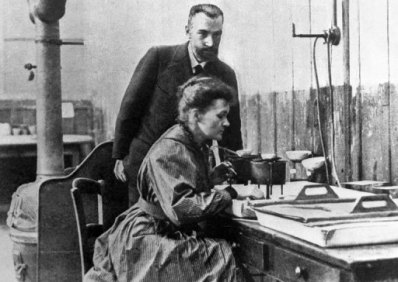 Once the first few tons of pitchblende arrived in the courtyard outside the hangar, the real back-breaking work could begin. It quickly became apparent that radium would be the easier of the two elements to extract, so the Curies focused on that. They divided the work, Pierre concentrating on the physics and determining its physical properties, and Marie on the chemistry of the extraction process. She carried out an exhaustive series of successive cleanings and boilings of the pitchblende in great twenty kilogram [forty-four pound] batches, stirring the enormous pots with an iron rod almost as tall as she was. She then used chemical processes to purify it further, and crystallize the residues. Initially, she had thought that radium made up approximately one percent of the pitchblende. It turned out that the actual figure was closer to one millionth of one percent. It took her thousands of purifications and almost seven tons of pitchblende to produce a single gram of radium.
Once the first few tons of pitchblende arrived in the courtyard outside the hangar, the real back-breaking work could begin. It quickly became apparent that radium would be the easier of the two elements to extract, so the Curies focused on that. They divided the work, Pierre concentrating on the physics and determining its physical properties, and Marie on the chemistry of the extraction process. She carried out an exhaustive series of successive cleanings and boilings of the pitchblende in great twenty kilogram [forty-four pound] batches, stirring the enormous pots with an iron rod almost as tall as she was. She then used chemical processes to purify it further, and crystallize the residues. Initially, she had thought that radium made up approximately one percent of the pitchblende. It turned out that the actual figure was closer to one millionth of one percent. It took her thousands of purifications and almost seven tons of pitchblende to produce a single gram of radium.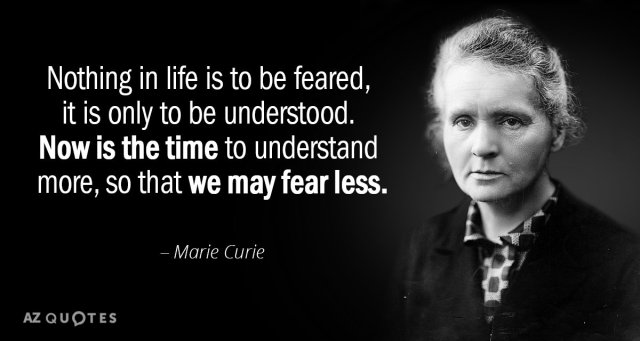
 We are living today in a maelstrom of misinformation. Whether the Earth is flat or spherical, do vaccines cause autism or not, is the climate changing or is climate change just a vast left-wing conspiracy, these were once questions easily answered by research, empirical evidence and facts. Now they are matters of opinion in which everyone brings their own version of reality to the table and the winner is the one who can shout the loudest and dig in his heels the hardest. No civilized society, no democracy can stand without some fundamental agreement about how to determine what is real and what is not. We can agree to disagree on matters of opinion, like whether vanilla is better than chocolate. We cannot agree to disagree on matters of fact, like whether or not vanilla and chocolate exist.
We are living today in a maelstrom of misinformation. Whether the Earth is flat or spherical, do vaccines cause autism or not, is the climate changing or is climate change just a vast left-wing conspiracy, these were once questions easily answered by research, empirical evidence and facts. Now they are matters of opinion in which everyone brings their own version of reality to the table and the winner is the one who can shout the loudest and dig in his heels the hardest. No civilized society, no democracy can stand without some fundamental agreement about how to determine what is real and what is not. We can agree to disagree on matters of opinion, like whether vanilla is better than chocolate. We cannot agree to disagree on matters of fact, like whether or not vanilla and chocolate exist. There is a body of research showing that too many choices actually interfere with our ability to determine which choice is best. In 2000, psychologists
There is a body of research showing that too many choices actually interfere with our ability to determine which choice is best. In 2000, psychologists  This effect isn’t limited to jams. Coffee, breakfast cereals, pasta and even beer, all force us to make choices between a baffling plethora of flavors and tastes. Do you realize that there are 16 varieties of Cheerios alone? Now imagine this when extrapolated to the number of colleges, housing options, retirement and healthcare plans we have to choose from. We now live in an internet age in which this can even be applied to our individual reality.
This effect isn’t limited to jams. Coffee, breakfast cereals, pasta and even beer, all force us to make choices between a baffling plethora of flavors and tastes. Do you realize that there are 16 varieties of Cheerios alone? Now imagine this when extrapolated to the number of colleges, housing options, retirement and healthcare plans we have to choose from. We now live in an internet age in which this can even be applied to our individual reality. n 2015 Google conducted
n 2015 Google conducted  Although this was simply research, not an actual
Although this was simply research, not an actual 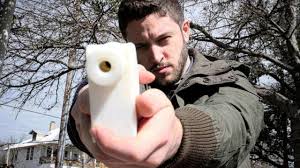 The average person will now be able to freely download the plans for a 3D printed gun off of the internet. That means they will, with the aid of a 3D printer of CNC machine, be able to print their very own gun in the privacy of their home. This has gotten a lot of play in the media and alarmed a number of people, and while some of the public concern about this may be warranted, it does not create an insurmountable problem.
The average person will now be able to freely download the plans for a 3D printed gun off of the internet. That means they will, with the aid of a 3D printer of CNC machine, be able to print their very own gun in the privacy of their home. This has gotten a lot of play in the media and alarmed a number of people, and while some of the public concern about this may be warranted, it does not create an insurmountable problem. Obviously, the idea of someone using this emerging technology to create their own gun raises a number of issues. The weapon would not have any serial number or require any form of registration, raising the specter of untraceable weapons that could be used to commit all manner of crimes and terrorist attacks. It is not widely known, however, but it has always been legal in the United States for someone to make their own gun. The difference is that until now, the knowledge of how to do so was in the hands of a rather small and manageable number of people. The new technology doesn’t create the risk of untraceable weapons, but it does massively expand the number of people able to do so.
Obviously, the idea of someone using this emerging technology to create their own gun raises a number of issues. The weapon would not have any serial number or require any form of registration, raising the specter of untraceable weapons that could be used to commit all manner of crimes and terrorist attacks. It is not widely known, however, but it has always been legal in the United States for someone to make their own gun. The difference is that until now, the knowledge of how to do so was in the hands of a rather small and manageable number of people. The new technology doesn’t create the risk of untraceable weapons, but it does massively expand the number of people able to do so. Additionally, while it is currently possible for the home hobbyist to print a gun, they can’t print the ammunition. A bullets are metal and require an explosive, typically in the form of what’s called smokeless powder, to propel themselves. Neither 3D printers nor CNC machines can produce that, so for the foreseeable future all those 3D printed guns will still need commercially available ammunition. This provides two ways to legally eliminate most of the problems that 3D printed guns create.
Additionally, while it is currently possible for the home hobbyist to print a gun, they can’t print the ammunition. A bullets are metal and require an explosive, typically in the form of what’s called smokeless powder, to propel themselves. Neither 3D printers nor CNC machines can produce that, so for the foreseeable future all those 3D printed guns will still need commercially available ammunition. This provides two ways to legally eliminate most of the problems that 3D printed guns create. It’s also possible that we might be able to use one emerging technology to solve problems created by another. It is now possible for ammunition manufacturers to use lasers to inexpensively engrave the inside of every bullet casing with a unique identification number. Since the number would be on the inside of the casing, any attempt to obscure or change it would destroy the bullet. This would allow the police to match any casings found at a crime scene to the person who purchased the ammo, regardless of whether the bullet was fired from a conventional firearm or a 3D printed one.
It’s also possible that we might be able to use one emerging technology to solve problems created by another. It is now possible for ammunition manufacturers to use lasers to inexpensively engrave the inside of every bullet casing with a unique identification number. Since the number would be on the inside of the casing, any attempt to obscure or change it would destroy the bullet. This would allow the police to match any casings found at a crime scene to the person who purchased the ammo, regardless of whether the bullet was fired from a conventional firearm or a 3D printed one.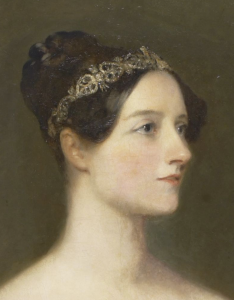 This Saturday marks the 201st birthday of Ada Lovelace. Born Ada Byron, the only legitimate daughter of Lord Byron, she defied the conventions of her time and became a brilliant mathematician. Along the way she and her mentor turned partner Charles Babbage tried to jump start the computer revolution a century before its time, and although they fell somewhat short of that goal, she became recognized as the world’s first computer programmer.
This Saturday marks the 201st birthday of Ada Lovelace. Born Ada Byron, the only legitimate daughter of Lord Byron, she defied the conventions of her time and became a brilliant mathematician. Along the way she and her mentor turned partner Charles Babbage tried to jump start the computer revolution a century before its time, and although they fell somewhat short of that goal, she became recognized as the world’s first computer programmer.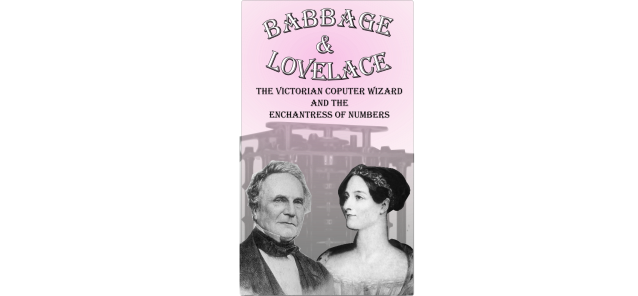
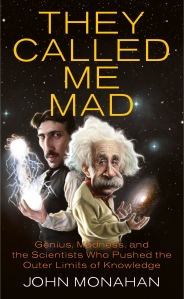 I recently gave a talk about my book to the Capital Area Skeptics.
I recently gave a talk about my book to the Capital Area Skeptics.  It’s kind of difficult to plan where you’re going if you don’t know where your at. That’s increasingly a problem as we become more and more detached about the state the world is in. Our picture of our world is skewed by the press, politicians, social media and frequently, our own brains.
It’s kind of difficult to plan where you’re going if you don’t know where your at. That’s increasingly a problem as we become more and more detached about the state the world is in. Our picture of our world is skewed by the press, politicians, social media and frequently, our own brains.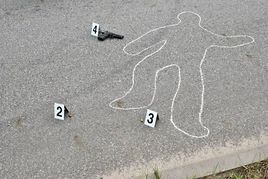 According to
According to 
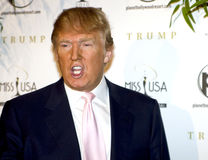 Politicians too use fear as a way to bring in voters and get them to the polls. That’s why
Politicians too use fear as a way to bring in voters and get them to the polls. That’s why  Nicola Tesla, one of the greatest inventors in history, was born 160 years ago today, July 10, 1856, and in the 160 years since, his legend has only grown. In his honor, here is a brief excerpt about him from my book,
Nicola Tesla, one of the greatest inventors in history, was born 160 years ago today, July 10, 1856, and in the 160 years since, his legend has only grown. In his honor, here is a brief excerpt about him from my book,  The walrus mustached business magnate went to Tesla’s lab to see for himself what the young upstart had come up with. Within moments of his arrival, Westinghouse was craning and bending to get a better look at the wondrous machines and gadgets that filled Tesla’s lab. The business man was soon asking the young inventor questions about this device or that. Tesla was impressed with the intelligence of the questions. The two men had a natural affinity for one another, and quickly became friends.
The walrus mustached business magnate went to Tesla’s lab to see for himself what the young upstart had come up with. Within moments of his arrival, Westinghouse was craning and bending to get a better look at the wondrous machines and gadgets that filled Tesla’s lab. The business man was soon asking the young inventor questions about this device or that. Tesla was impressed with the intelligence of the questions. The two men had a natural affinity for one another, and quickly became friends.
 On January 4, 1903, before an audience of 1,500 spectators and reporters, the condemned pachyderm was prepared. Copper electrodes were attached to her feet and wires were run to a generator. When the technicians gave the signal, the switch was thrown and the 6,600 volt AC charge ran through Topsy’s body. As onlookers gasped, smoke rose from her feet, and the mighty elephant keeled over dead. Edison’s assistants filmed the entire spectacle, and the film was later released to the public.
On January 4, 1903, before an audience of 1,500 spectators and reporters, the condemned pachyderm was prepared. Copper electrodes were attached to her feet and wires were run to a generator. When the technicians gave the signal, the switch was thrown and the 6,600 volt AC charge ran through Topsy’s body. As onlookers gasped, smoke rose from her feet, and the mighty elephant keeled over dead. Edison’s assistants filmed the entire spectacle, and the film was later released to the public.


